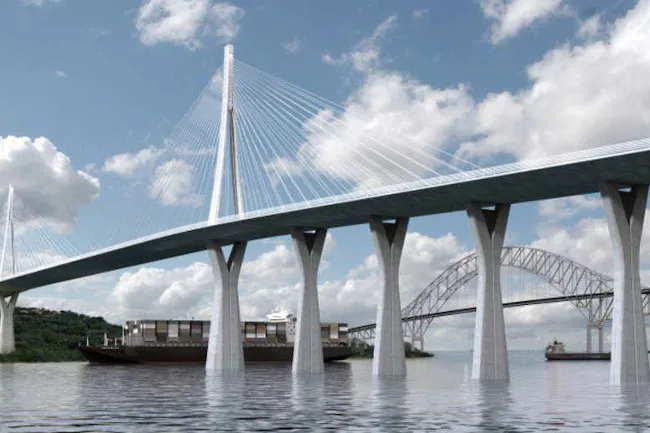Canada’s infrastructure minister, Denis Label, officially broke ground for Montreal’s replacement Champlain Bridge, saying the project will likely cost US$3.42 billion.
The 3.4km Champlain Bridge Corridor Project, including spans and highway expansions, is expected to be completed by 2019.
SNC-Lavalin, the 50% stakeholder in the winning consortium Signature on the Saint-Lawrence, recently announced it had finalised the deal with new Champlain Bridge owner Infrastructure Canada. Signature on the Saint-
June 25, 2015
Read time: 3 mins
Canada’s infrastructure minister, Denis Label, officially broke ground for Montreal’s replacement Champlain Bridge, saying the project will likely cost US$3.42 billion.
The 3.4km Champlain Bridge Corridor Project, including spans and highway expansions, is expected to be completed by 2019.
SNC-Lavalin, the 50% stakeholder in the winning consortium Signature on the Saint-Lawrence, recently announced it had finalised the deal with new Champlain Bridge owner Infrastructure Canada. Signature on the Saint-Lawrence will design, construct, finance, operate, maintain and rehabilitate. SSL has entered into a date-certain, fixed-priced contract of around $2.15 billion and the concession period runs October 2049.
The partnership of SNC-Lavalin,2758 Flatiron and 4761 Dragados Canada are responsible for construction of the project. Consortium equity providers include SNC-Lavalin Capital, 917 ACS Infrastructure Canada and 981 HOCHTIEF PPP Solutions North America. The project is designed by T.Y. Lin International, International Bridge Technologies, SNC-Lavalin and MMM.
The existing bridge – a steel cantilever truss structure built in 1957 – spans the St. Lawrence River which flows from the Great Lakes and is the route for ocean-going ships to reach cities including Chicago deep in the interior of northern North America.
The old bridge is also one of the busiest crossings in the country, carrying between 40-60 million cars, trucks and buses a year. As well, over 11 million transit users travel across it annually. In terms of Canada-US trade, more than $16 billion worth of goods and services use the corridor annually.
The new Champlain Bridge is expected to feature a three-corridor design, including two three-lane corridors for vehicles and a two-lane public transport corridor capable of accommodating a light rail transit system. It will also have a multi-use path for pedestrians and cyclists.
Canada-based Canam-Bridge recently announced it had won the contract to fabricate the superstructure for the new bridge, for which the company expects to use around at least 45,000tonnes of steel.
In a separate statement, ACS said it had secured financing for its work, according to Spanish media. Private finance for the project includes a long-term bond issue in two series subscribed to by HSBC Securities and National Bank Financial.
The short-term finance during the construction period will include bank debt of $1.16 billion, through a syndicate of National Bank of Canada, Bank of Tokyo-3055 Mitsubishi UFJ, Bank of Nova Scotia, Caisse Centrale Desjardins du Quebec, 2714 Sumitomo Mitsui, HSBC Bank Canada, Toronto-Dominion Bank and Bank of China.
There will also be capital contributed by shareholders of the consortium. The public finance portion of the funding will come through three payments associated with the achievement of targets in the project.
The 3.4km Champlain Bridge Corridor Project, including spans and highway expansions, is expected to be completed by 2019.
SNC-Lavalin, the 50% stakeholder in the winning consortium Signature on the Saint-Lawrence, recently announced it had finalised the deal with new Champlain Bridge owner Infrastructure Canada. Signature on the Saint-Lawrence will design, construct, finance, operate, maintain and rehabilitate. SSL has entered into a date-certain, fixed-priced contract of around $2.15 billion and the concession period runs October 2049.
The partnership of SNC-Lavalin,
The existing bridge – a steel cantilever truss structure built in 1957 – spans the St. Lawrence River which flows from the Great Lakes and is the route for ocean-going ships to reach cities including Chicago deep in the interior of northern North America.
The old bridge is also one of the busiest crossings in the country, carrying between 40-60 million cars, trucks and buses a year. As well, over 11 million transit users travel across it annually. In terms of Canada-US trade, more than $16 billion worth of goods and services use the corridor annually.
The new Champlain Bridge is expected to feature a three-corridor design, including two three-lane corridors for vehicles and a two-lane public transport corridor capable of accommodating a light rail transit system. It will also have a multi-use path for pedestrians and cyclists.
Canada-based Canam-Bridge recently announced it had won the contract to fabricate the superstructure for the new bridge, for which the company expects to use around at least 45,000tonnes of steel.
In a separate statement, ACS said it had secured financing for its work, according to Spanish media. Private finance for the project includes a long-term bond issue in two series subscribed to by HSBC Securities and National Bank Financial.
The short-term finance during the construction period will include bank debt of $1.16 billion, through a syndicate of National Bank of Canada, Bank of Tokyo-
There will also be capital contributed by shareholders of the consortium. The public finance portion of the funding will come through three payments associated with the achievement of targets in the project.








